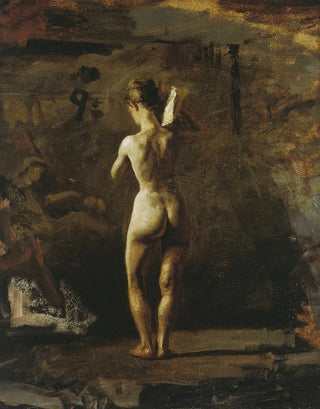Art print | Study for William Rush sculpting his allegorical figure of the Schuylkill River - Thomas Eakins


View from behind

Frame (optional)
The artwork "Study for William Rush sculpting his allegorical figure of the Schuylkill River" by Thomas Eakins is part of an artistic tradition where the depiction of the human body and nature intertwine with a narrative depth. This study, created by one of the masters of American realism, evokes both the beauty of artistic gesture and the symbolism of water, a vital element imbued with meaning. By immersing oneself in this piece, the viewer is invited to explore not only Eakins's technical virtuosity but also universal themes of creation, identity, and the relationship between man and his environment. The light illuminating the scene, the delicate textures, and the dynamic poses capture a suspended moment, where the sculptor, William Rush, appears to dialogue with his own creation.
Style and uniqueness of the work
Eakins's style is characterized by meticulous attention to detail and a deep understanding of human anatomy. In this study, every muscle, every curve is rendered with precision that reflects his commitment to realism. Rush's figure, while grounded in reality, takes on an almost mythic dimension, reminiscent of the artists of ancient Greece who sculpted allegorical figures. The posture of the sculptor, both focused and powerful, conveys an inner strength, while the treatment of light and shadow enhances the drama of the scene. Eakins succeeds in capturing the very essence of the creative act, where the artist becomes both the creator and the creation. This duality is reflected in the nuances of the palette, where earthy tones blend with flashes of light, creating an atmosphere that is both intimate and grandiose.
The artist and his influence
Thomas Eakins, an emblematic figure of 19th-century American art, left an indelible mark on the world of painting and sculpture. Trained in Paris, he skillfully combined European influences with American realities, developing a unique style that redefined the aesthetic standards of his time. Eakins

Matte finish

View from behind

Frame (optional)
The artwork "Study for William Rush sculpting his allegorical figure of the Schuylkill River" by Thomas Eakins is part of an artistic tradition where the depiction of the human body and nature intertwine with a narrative depth. This study, created by one of the masters of American realism, evokes both the beauty of artistic gesture and the symbolism of water, a vital element imbued with meaning. By immersing oneself in this piece, the viewer is invited to explore not only Eakins's technical virtuosity but also universal themes of creation, identity, and the relationship between man and his environment. The light illuminating the scene, the delicate textures, and the dynamic poses capture a suspended moment, where the sculptor, William Rush, appears to dialogue with his own creation.
Style and uniqueness of the work
Eakins's style is characterized by meticulous attention to detail and a deep understanding of human anatomy. In this study, every muscle, every curve is rendered with precision that reflects his commitment to realism. Rush's figure, while grounded in reality, takes on an almost mythic dimension, reminiscent of the artists of ancient Greece who sculpted allegorical figures. The posture of the sculptor, both focused and powerful, conveys an inner strength, while the treatment of light and shadow enhances the drama of the scene. Eakins succeeds in capturing the very essence of the creative act, where the artist becomes both the creator and the creation. This duality is reflected in the nuances of the palette, where earthy tones blend with flashes of light, creating an atmosphere that is both intimate and grandiose.
The artist and his influence
Thomas Eakins, an emblematic figure of 19th-century American art, left an indelible mark on the world of painting and sculpture. Trained in Paris, he skillfully combined European influences with American realities, developing a unique style that redefined the aesthetic standards of his time. Eakins






